My wife loves reading the paper. She likes books printed on paper. I'm enthusiastic about going totally digital for my reading and particularly I like the idea of being able to carry a huge library with me and have the ability to download or purchase any book that strikes my interest.
This morning as we sat on the balcony, overlooking the sea, with the sea breeze in our hair, I realised that ebook readers have an important advantage over the paper alternative - the pages don't get blown around in the wind!
Just a thought.
Monday, January 31, 2011
A Kindle in Australia review
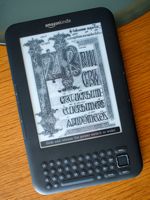 I've had the smaller international Kindle for a few weeks now, most recently while on holiday. While the iPad is a wonderful reader, particularly for indoor use, there is definitely a place for the Kindle.
I've had the smaller international Kindle for a few weeks now, most recently while on holiday. While the iPad is a wonderful reader, particularly for indoor use, there is definitely a place for the Kindle.The Kindle is lighter and thinner and, being an eInk display, just gets easier to read as the ambient light gets brighter. (Below is a view of the screen in direct sunlight).
Wireless broadband is built in. Here in Australia it uses Telstra's network, there is no contract, no fees and it mostly works very well. At any time, you can turn wireless on, browse the Amazon Kindle store (of some 500,000 books), purchase something and within a minute or two it is on your home screen.
This can be addictive, particularly when there are titles for one or two dollars.
The device can also use Wifi which is faster. At the moment there is no charge for the 3G wireless delivery of books, the cost is built-in to the cover price, and there is an "experimental" web browser, WebKit based, that also currently gets this free bandwidth.
The web browser is usable but not pleasant. The screen doesn't have enough speed or pixels to make it all come together, but if you're desperate for the news it's workable. The arrow pad lets you move a cursor around the screen from link to link and there's a magnify option. I've been able to use gMail and Google News but even a phone is better choice if available.

I'm running software version 3.0.2 and so far I've had a few crashes or hangs. Mostly either in the web browser or while marking text in the reader. On one occasion I left it in my bag charged, asleep, and next day found it completely flat. My guess is that as wireless was on it somehow drained itself trying to reach a basestation in a bad coverage location.
These days I leave wireless off and just turn it on to purchase books.
As well as getting books directly through the built-in store you can plug the device into a computer, where it mounts as a disk, and simply drag titles in .TXT or .MOBI format over to it where they join the rest of the list. I think there was a bit over 3GB free when new and now it's 2.5GB despite the fact that I have 760 books in mine now.
Many of the computer books I buy from O'Reilly publishing. One great thing about O'Reilly is that once you buy a book you can download it in many different formats including ePub for the iPad and .mobi for Kindle.
As there is a Kindle application for iPad, books I buy from Amazon can also be read on the iPad.
I've owned Sony readers and played with all the others I've encountered in stores and the Kindle is the best beside my iPad.
Australian electronic book scandal
What is the story with buying electronic books in Australia? The range is much smaller and the prices are higher. Mr who?, break down this wall!
Sunday, January 30, 2011
Mid North Coast Radio Expo report
Once again, we've combined an annual catch up with family and friends with the Mid North Coast Radio Expo at Coffs Harbour.
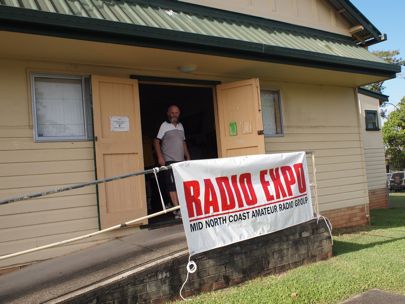
It's a well organised event, $5 to get in and free cups of tea which are appreciated. There was some interesting second hand gear on sale.
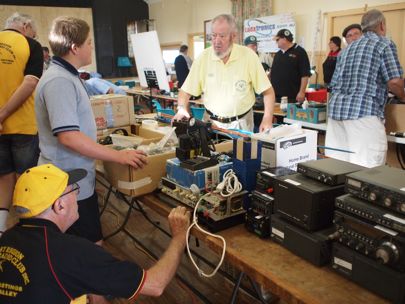
There was a very interesting demonstration of a Genesis Radio G80 Software defined radio.
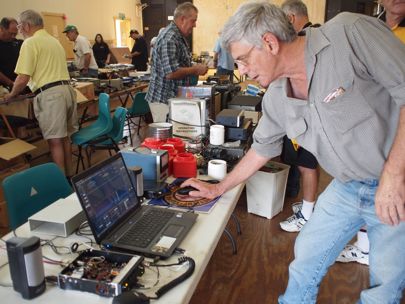
This year was definitely quieter than last year. Perhaps the lack of the historical radio display left a hole.
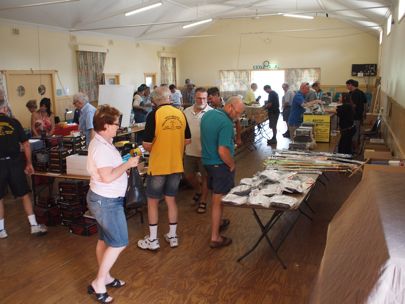
I enjoyed myself and bought a book about Edison and a new balun. Already looking forward to next year.

It's a well organised event, $5 to get in and free cups of tea which are appreciated. There was some interesting second hand gear on sale.

There was a very interesting demonstration of a Genesis Radio G80 Software defined radio.

This year was definitely quieter than last year. Perhaps the lack of the historical radio display left a hole.

I enjoyed myself and bought a book about Edison and a new balun. Already looking forward to next year.
Sunday, January 23, 2011
Possibly the best shack in all of ham radio
I've just had the pleasure of a visit to Melbourne and another visit to the fine shack of Ralph, VK3ZZC.

Like a Tardis, it's small on the outside but huge on the inside.
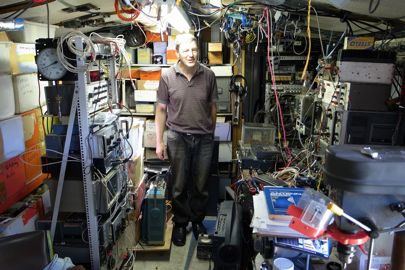
Stocked with modern equipment, such as this HP frequency counter with a nixie tube display.

Ralph has figured out how to weld aluminium and hopefully will describe the method on his web site soon.
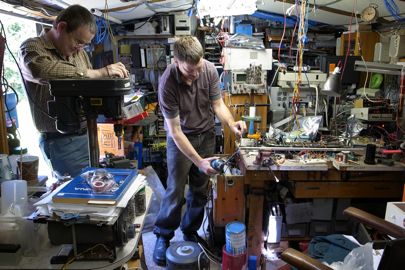
The only thing that needs further development is the antenna farm, but progress is well under way. I particularly like the shielded loop antenna with an "armstrong" rotator.
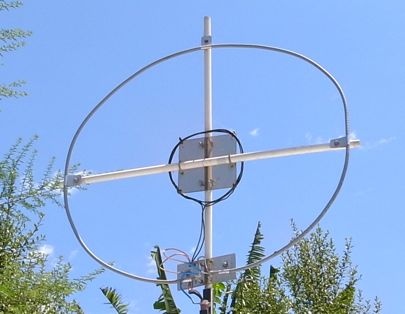
Here's how you rotate the loop from below:
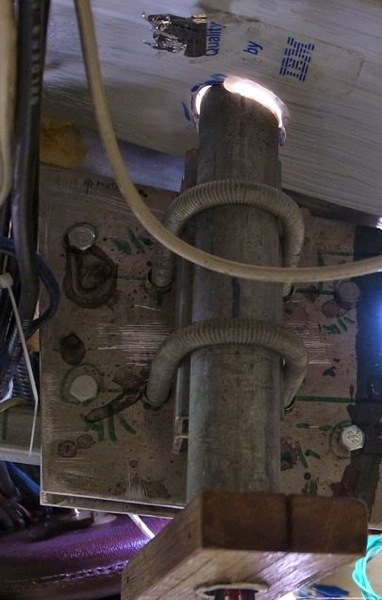
Ralph makes his own U bolts with a home made bender. Nice work.
Wonderful to catch up with everyone, and thanks Ralph for the gift pack! I said "possibly" the best shack, the only issue is extreme temperatures on some days (55C has been the observed peak).

Like a Tardis, it's small on the outside but huge on the inside.

Stocked with modern equipment, such as this HP frequency counter with a nixie tube display.

Ralph has figured out how to weld aluminium and hopefully will describe the method on his web site soon.

The only thing that needs further development is the antenna farm, but progress is well under way. I particularly like the shielded loop antenna with an "armstrong" rotator.

Here's how you rotate the loop from below:

Ralph makes his own U bolts with a home made bender. Nice work.
Wonderful to catch up with everyone, and thanks Ralph for the gift pack! I said "possibly" the best shack, the only issue is extreme temperatures on some days (55C has been the observed peak).
Friday, January 21, 2011
Built an excellent kit: MKARS80 80m Huff and Puff
Over the past few days the shack has been in construction mode. The MKARS80 from Radio-Kits UK, is a QRP (5W) 80m SSB transceiver based on the BITX20 design (with switchable two-way gain stages so the crystal filter is shared between receive and transmit).
This design includes a PIC microprocessor that serves as a frequency counter and provides "huff and puff" frequency stabilisation. As a bonus it displays DC voltage.
It's a clever design, simple enough for me to understand but I want to give praise the thought that went in to the kit in particular.
The construction instructions are very clear and components are grouped in numbered bags which have been divided up in part to avoid components that might be confused with each other being on the bench at the same time.
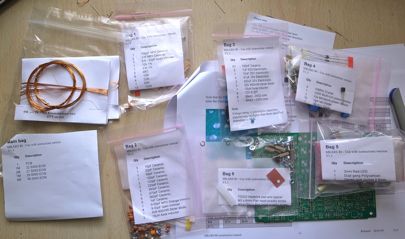
Warnings are given about common errors, like mistaking 4k7 resistors with 47k (red and orange can be hard to tell apart under some lighting conditions).
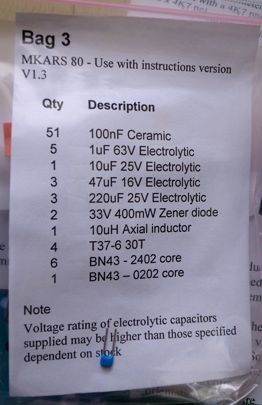 Building a radio kit is a bit of a test of concentration. Errors are costly and the damage done removing a mis-placed part can be unsightly and sometimes fatal to parts of the board, so it's best to double check.
Building a radio kit is a bit of a test of concentration. Errors are costly and the damage done removing a mis-placed part can be unsightly and sometimes fatal to parts of the board, so it's best to double check.
I take it slow and have a break every 30 minutes. Lots of cups of tea, good lighting and Radio National on in the background is my secret.
Happily, once the tedious small components, resistors and small capacitors, are done it feels like the back is broken until you get to the toroid coil winding phase. Here the instructions are a little odd suggesting that a 30 turn toroid be wound from the middle with 15 turns either way.

The supplied parts were accurately picked, I had one excess capacitor and was down one 2.5mm nut which was no problem at all. My kit included a note explaining that a 4k7 potentiometer had been substituted for the 10k, but in fact the specified part was packed.
Although I've played with electronics for many years, there's lots for me to learn. Building a kit builds my familiarity with electronic components and their sometimes confusing markings. Constructing the inductors gives me the confidence to home brew my own in other contexts. Aligning and debugging the project gives me a good understanding of how the circuit works and the logic of debugging a circuit.

In this case, the kit came to life without any problem and I was able to bring it on to the 80m band quite easily and was soon listening to stations talking. I was almost disappointed when it worked right off as the debugging phase is often the most valuable learning experience, but all credit to the kit designers is due.
I've heard about "huff and puff" stabilisation before but never used it. It's a clever idea where the VFO is pushed or pulled on to a series of fixed frequencies and held there by the application of a voltage that alters the VFO frequency. In use it's a little weird, it fights you if you tune a small amount, then it lets go and you can tune freely. When you stop it locks on to the nearest fixed spot.
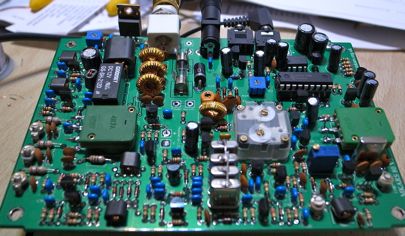
The LCD display shows the operating frequency and the Huff and Puff status as +- indicators which helps me to understand what's going on. Power supply voltage display will be a help when running off batteries, which is one of the reasons why I like simple transceiver designs - they tend to use a tenth of the power on receive of any commercial set and are more suited to portable operation for that reason.
There's even a file with a drilling template for the case.
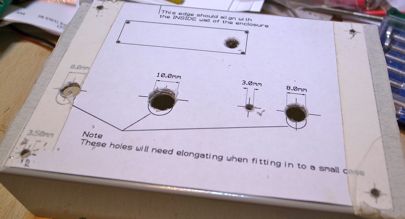
I enjoyed building the MKARS80 and look forward to getting it on the air.
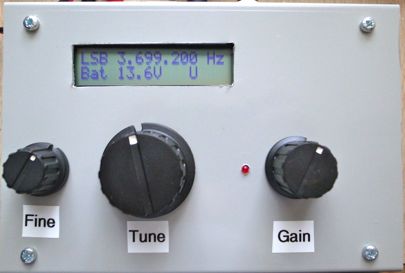
A particularly clever design feature is the transmit LED extinguishes at full modulation so you can adjust your level without a speech limiter.
Tuning is backwards, clockwise goes down in frequency, and the main tuning is very sensitive on my radio so I tend to use fine tuning most of the time. (Cleverly fine tuning also goes backwards - if it didn't it would be very confusing).
The microphone is connected via a 3.5mm stereo plug with the PTT on one contact and the Mic on the other, unfortunately it's the reverse wiring to the mic on the MMR40 I built a while back.
Kits are important and there should be more of them. This one has been designed with great professionalism and with the builder firmly in mind.
Update: First contact!
I listened to the end of a net on 3.600 and then called CQ. David, VK2EZD replied and gave me a good report including audio quality. David is located south of Sydney at Albion Park Rail which I make 120km away. There's a lot of static about, which makes it heavy going without AGC or noise blanking, but we had a pretty good chat before I had to run off to greet the family. Thanks Dave.
One problem has emerged. After transmitting for a while the VFO drifted way off frequency. Clearly the heat takes it out of huff and puff stabilisation range. I need to look in to this.
Update: warm up needed
I participated in the net on 3.600 at 7:30 again this evening (Tuesday 25th Jan).
Was able to copy and was copied by vk2ezd David, vk2ane Bill, vk4ath Tom and vk2nc John. This time I let the radio warm up for about 30 minutes before the net and it certainly behaves better.
Reports of my signal were very good including audio quality which is gratifying.
Update 2: installed NP0 VFO capacitors
Even with the warm up period my unit would drift when I started talking for a while. The solution is to replace two capacitors with zero temperature coefficient versions. I did this and now after about 10 minutes it's rock solid even during a long transmission. There are good instructions for this mod here.
Thanks to John VK2ASU for the prod and for having a QSO to test that all was working afterwards.
This design includes a PIC microprocessor that serves as a frequency counter and provides "huff and puff" frequency stabilisation. As a bonus it displays DC voltage.
It's a clever design, simple enough for me to understand but I want to give praise the thought that went in to the kit in particular.
The construction instructions are very clear and components are grouped in numbered bags which have been divided up in part to avoid components that might be confused with each other being on the bench at the same time.

Warnings are given about common errors, like mistaking 4k7 resistors with 47k (red and orange can be hard to tell apart under some lighting conditions).
 Building a radio kit is a bit of a test of concentration. Errors are costly and the damage done removing a mis-placed part can be unsightly and sometimes fatal to parts of the board, so it's best to double check.
Building a radio kit is a bit of a test of concentration. Errors are costly and the damage done removing a mis-placed part can be unsightly and sometimes fatal to parts of the board, so it's best to double check.I take it slow and have a break every 30 minutes. Lots of cups of tea, good lighting and Radio National on in the background is my secret.
Happily, once the tedious small components, resistors and small capacitors, are done it feels like the back is broken until you get to the toroid coil winding phase. Here the instructions are a little odd suggesting that a 30 turn toroid be wound from the middle with 15 turns either way.

The supplied parts were accurately picked, I had one excess capacitor and was down one 2.5mm nut which was no problem at all. My kit included a note explaining that a 4k7 potentiometer had been substituted for the 10k, but in fact the specified part was packed.
Although I've played with electronics for many years, there's lots for me to learn. Building a kit builds my familiarity with electronic components and their sometimes confusing markings. Constructing the inductors gives me the confidence to home brew my own in other contexts. Aligning and debugging the project gives me a good understanding of how the circuit works and the logic of debugging a circuit.

In this case, the kit came to life without any problem and I was able to bring it on to the 80m band quite easily and was soon listening to stations talking. I was almost disappointed when it worked right off as the debugging phase is often the most valuable learning experience, but all credit to the kit designers is due.
I've heard about "huff and puff" stabilisation before but never used it. It's a clever idea where the VFO is pushed or pulled on to a series of fixed frequencies and held there by the application of a voltage that alters the VFO frequency. In use it's a little weird, it fights you if you tune a small amount, then it lets go and you can tune freely. When you stop it locks on to the nearest fixed spot.

The LCD display shows the operating frequency and the Huff and Puff status as +- indicators which helps me to understand what's going on. Power supply voltage display will be a help when running off batteries, which is one of the reasons why I like simple transceiver designs - they tend to use a tenth of the power on receive of any commercial set and are more suited to portable operation for that reason.
There's even a file with a drilling template for the case.

I enjoyed building the MKARS80 and look forward to getting it on the air.

A particularly clever design feature is the transmit LED extinguishes at full modulation so you can adjust your level without a speech limiter.
Tuning is backwards, clockwise goes down in frequency, and the main tuning is very sensitive on my radio so I tend to use fine tuning most of the time. (Cleverly fine tuning also goes backwards - if it didn't it would be very confusing).
The microphone is connected via a 3.5mm stereo plug with the PTT on one contact and the Mic on the other, unfortunately it's the reverse wiring to the mic on the MMR40 I built a while back.
Kits are important and there should be more of them. This one has been designed with great professionalism and with the builder firmly in mind.
Update: First contact!
I listened to the end of a net on 3.600 and then called CQ. David, VK2EZD replied and gave me a good report including audio quality. David is located south of Sydney at Albion Park Rail which I make 120km away. There's a lot of static about, which makes it heavy going without AGC or noise blanking, but we had a pretty good chat before I had to run off to greet the family. Thanks Dave.
One problem has emerged. After transmitting for a while the VFO drifted way off frequency. Clearly the heat takes it out of huff and puff stabilisation range. I need to look in to this.
Update: warm up needed
I participated in the net on 3.600 at 7:30 again this evening (Tuesday 25th Jan).
Was able to copy and was copied by vk2ezd David, vk2ane Bill, vk4ath Tom and vk2nc John. This time I let the radio warm up for about 30 minutes before the net and it certainly behaves better.
Reports of my signal were very good including audio quality which is gratifying.
Update 2: installed NP0 VFO capacitors
Even with the warm up period my unit would drift when I started talking for a while. The solution is to replace two capacitors with zero temperature coefficient versions. I did this and now after about 10 minutes it's rock solid even during a long transmission. There are good instructions for this mod here.
Thanks to John VK2ASU for the prod and for having a QSO to test that all was working afterwards.
Sunday, January 09, 2011
Building a 40m DC receiver in an Altoids tin
I've made these before but they're fun. My objective is to eventually make a direct conversion receiver for 40m that is small enough to fit inside an Altoids tin, including the 9V battery. As you can see, I'm a long way from that objective:
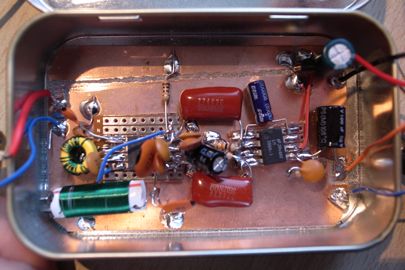
This is the classic NE602 LM386 design from EMRFD except that I'm using a permeability tuned oscillator. I'm hunting for long brass machine screws (and the nuts to fit, probably about 3cm long and 3mm diameter. (If anyone can suggest a source I'd be most grateful). A steel screw works but quenches the oscillator as I screw it in. (Is that why brass is used?).
The other issue in miniaturisation is getting small components - some of my capacitors are huge, due to voltage rating, and I need to collect smaller ones.

This is the classic NE602 LM386 design from EMRFD except that I'm using a permeability tuned oscillator. I'm hunting for long brass machine screws (and the nuts to fit, probably about 3cm long and 3mm diameter. (If anyone can suggest a source I'd be most grateful). A steel screw works but quenches the oscillator as I screw it in. (Is that why brass is used?).
The other issue in miniaturisation is getting small components - some of my capacitors are huge, due to voltage rating, and I need to collect smaller ones.
Saturday, January 08, 2011
Air Superdrive - a triumph of minimalist design
Although I rarely need a DVD/CD drive for my Air, from time to time it's still handy.
Today I plunked down $99 to get the Air Superdrive. Works nicely but the really striking thing about it is that this product is at the peak of Jobsian minimalistic design.

It's symmetrical, clean, and functional. They've left out the activity light, and the eject hole and the result is a piece of art.
The only pity is that they have to put all those silly compliance labels on the base but even those are very low key.
It is truly a triumph.
Today I plunked down $99 to get the Air Superdrive. Works nicely but the really striking thing about it is that this product is at the peak of Jobsian minimalistic design.

It's symmetrical, clean, and functional. They've left out the activity light, and the eject hole and the result is a piece of art.
The only pity is that they have to put all those silly compliance labels on the base but even those are very low key.
It is truly a triumph.
Thursday, January 06, 2011
Sydney Python meeting, good talk, great food
Enjoyed this evening's Sydney Python (SyPy) talk hosted by Google. The supplied food was particularly nice and even included marinated octopus:

Richard Volpato talked on "Making R restfully enterprising with Django". Thanks Richard and thanks to Dylan for organising it.

Richard Volpato talked on "Making R restfully enterprising with Django". Thanks Richard and thanks to Dylan for organising it.
Sunday, January 02, 2011
The King's Speech - great film about broadcast radio tech from 1930's
There are wonderful microphones, mixing equipment and switchroom gear presumably for an early BBC World Service. There's also a wonderful scene with an announcer preparing to speak, complete with gargling and throat spray action.
Aside from this interesting dimension for me, it's a wonderful film for the whole family, wonderful photography and masterful performances.
These are clipped from the trailer, hope that's ok.
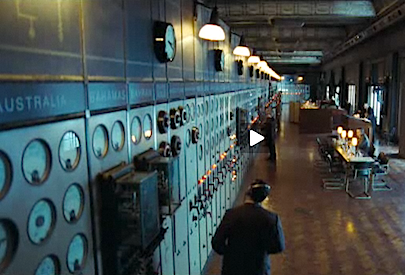
Looks like the levels going out to Australia are a bit low.
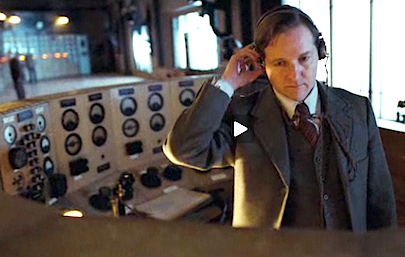
Uncomfortable headphones.
Cent-A-Meter CM113A hacking
 The Cent-A-Meter has an AC current sensor you clip over the mains wire coming in to your house, (there's a version with three sensors for three phase power). The sensor transmits data on 433.92MHz to a receiver in the house that displays how much power your house is using.
The Cent-A-Meter has an AC current sensor you clip over the mains wire coming in to your house, (there's a version with three sensors for three phase power). The sensor transmits data on 433.92MHz to a receiver in the house that displays how much power your house is using.Obviously I'd like to log the readings and display a graph of usage over a day and week. It's a well constructed device internally:
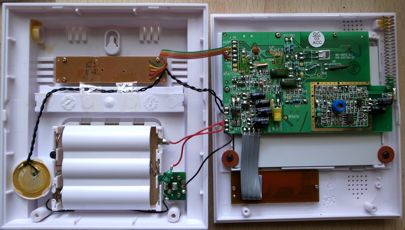
The main circuit board is clearly laid out and labelled:
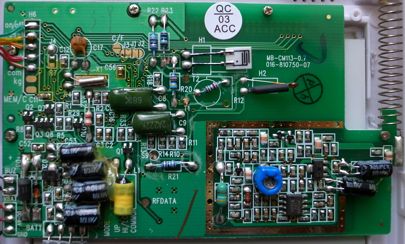
I like the RF board with its spring antenna on the right. Clearly labelled is a pad where you can pick up the serial data.
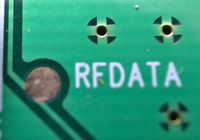 My hope was that the protocol would be somehow simple, perhaps a pulse that varies proportionally with the current detected - I understand some monitoring systems use the flashing LED on modern electronic power meters which flashes like this. Unfortunately for me it looks to be more sophisticated than that and the actual data packet is surprisingly long for just sending one reading.
My hope was that the protocol would be somehow simple, perhaps a pulse that varies proportionally with the current detected - I understand some monitoring systems use the flashing LED on modern electronic power meters which flashes like this. Unfortunately for me it looks to be more sophisticated than that and the actual data packet is surprisingly long for just sending one reading.
Anyhow this is a good start. It looks like there are receivers that can receive these signals so I might leave the standard client in tact and get an additional receiver to try amateur protocol analysis on.
Saturday, January 01, 2011
Dick Smith GH5930 HD Recorder mini review
 At $59.98 it's hard to resist the Dick Smith GH5930.
At $59.98 it's hard to resist the Dick Smith GH5930.As well as being a High Definition digital set top box with HDMI out, it has a USB host port on the front and can record to a USB key drive. The device has the electronic program guide broadcast from each station and you can select a program in that and it will record it.
The user interface is pretty clunky but it does the job and works well for me with a USB flash drive (I'm using an 8GB stick). I tried to get it going with a 750GB hard disk but ran in to multiple problems: it wouldn't format unless I'd already initialised the drive FAT32, formatting took ages, when I did record it seemed to lose the plot and didn't record.
There's a good thread on Whirlpool about this device and I'm not alone having FAT32 drive issues.
Pretty good for the money.
Update - firmware update
Just noticed there is a software update available here. It installed smoothly for me and all seems well.
Nothing terribly dramatic in the update, they say:
This (Nov 2 2010) firmware upgrade eliminates the SA Daylight Saving Bug. The following improvements were also added
- During Record, the orange “Record” graphic and the elapsed time indicator can now be removed from the screen by pressing the “Exit” button. If you attempt to change the channel or switch the unit off during a recording, the Record Symbol will re-appear as a reminder.
- The “Recording Complete” message now disappears after a few seconds instead of remaining on the screen until “Exit” is pressed.
- After a Time Limited recording (30, 60, 90 etc) the elapsed time indicator disappears at the end of the recording
- The “Do you want to re-scan” message now only appears with a major programming change, and disappears after a few seconds.
Aside from some problems recording to certain USB sticks, I'm still happy with this device for the price.
Time Magazine, why more expensive on iPad?
 Many years ago Time Magazine purchased a site license for some Mac software I wrote. I was grateful and in return took out a five year subscription to the magazine. The weekly overview of what happened is a cycle I like, it tends to overcome the daily need for news reports to come up with a big story when perhaps there isn't anything.
Many years ago Time Magazine purchased a site license for some Mac software I wrote. I was grateful and in return took out a five year subscription to the magazine. The weekly overview of what happened is a cycle I like, it tends to overcome the daily need for news reports to come up with a big story when perhaps there isn't anything.After a while though Time seemed tired and old so I let my subscription expire. Having been a subscriber I now get amazing offer letters from them trying to woo me back. They offer a deep discount on the cover price combined with a free gift. (The gifts look bad even in the picture they provide). The current price offer is $1.85 per week delivered in "dead tree format". The gift is a travel bag and binoculars.
Despite their obviously poor editorial judgement in choosing Mark Zuckerberg over Julian Assange as the person of the year, I thought I'd grab the iPad app and have a read.
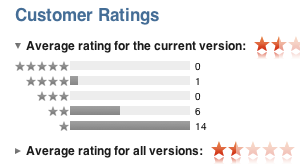
First up, the iTunes store is awash with bad ratings and comments for the iOS edition. Secondly they want you to pay $5.99 per copy to read it on a tablet. This smacks of a paper based publisher that wants to appear to track the trend to e-publishing while engineering a failure.
Why on earth isn't it cheaper to deliver electronically than printed to the door?
I bought an issue and the magazine looks great on the screen. The app uses a side swipe to move story to story and a vertical drag to read an article (there's no "pages" as such).
So, note to Richard Evans, President TIME International, who writes to me each year, I like your discount price for subscriptions but please let me have that in my iPad. By the way, I love the way they want you to peel off a "Yes" sticker and stick it in the FREE gift box - so oldey timey.
While I'm here, it's clear that Apple needs to come out with a bundled iMagazine app that avoids every magazine publisher re-inventing the wheel.
Update: cheap on kindle
I've just noticed that Time is $2.99 per month on the Amazon Kindle so that's about 75 cents a copy compared to $5.99 a copy on iPad. Also the 75 cents include delivery via wireless broadband.
Subscribe to:
Posts (Atom)